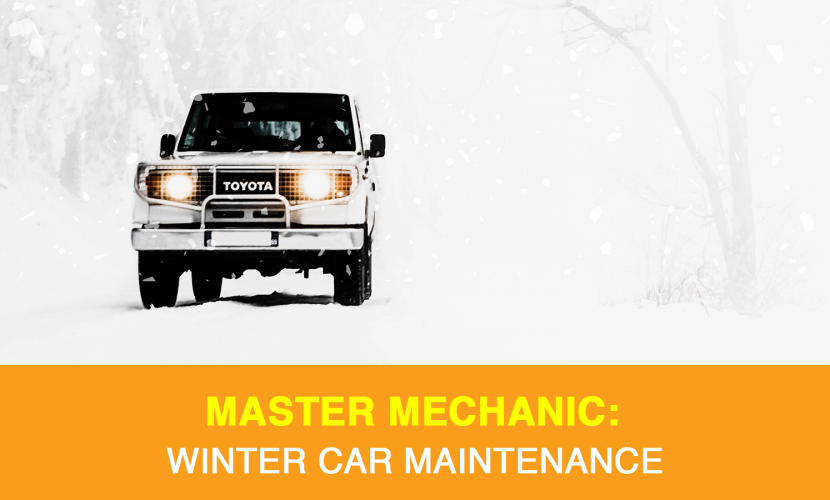
Master Mechanic: Winter Car Maintenance
Winter months are always busy at Master Mechanic. Too many drivers underestimate winter conditions and overestimate their cars capability (or their driving ability).
If you’ve read through your vehicle’s owner manual, you may have noticed that there are two separate schedules for maintenance: one for “normal” driving and one for “severe” driving.” The problem is that most Canadians assume that we’re driving under normal conditions because, for us, winter driving is normal! But, like most Canadians, you’d be wrong. The conditions that manufacturers identify as ‘severe’ vary a bit, but all include “driving in cold weather.”
Driving in severe conditions means you should follow a shorter car maintenance schedule to ensure that yourself, your passengers, and other drivers are safe on the road. In addition to regular service checks at your local Master Mechanic, there is preventative maintenance you can perform yourself to help keep your car running smoothly.
Winter Driving and Your Defroster
If you’ve ever lost visibility because the windows fog up suddenly, listen up! When the temperature drops, condensation occurs and reduces visibility dramatically. At its best, this can be an inconvenience, at its worst, it can be deadly. Your defroster, which blows warm, dry air on the interior windshield, is used to clear your windows when this happens. For it to do its job, you need to make sure it’s functioning correctly before hitting the road. If your defroster seems to be working fine, but you still notice condensation, you’ll want to get your door seals checked for wear-and-tear.
Keep Your Gas Tank At Least Half Full During Winter
The air volume in your tank contains moisture, and like all moisture, it can freeze in your fuel lines when the temperature drops below 0. Keeping your gas tank at least half full throughout the winter months lowers the air volume in your tank. Lower air volume helps to limit moisture in your tank and lowers the chance of it freezing. A full gas tank can also add extra weight to your car which helps improve traction on icy roads.
Switch to a Winter‐Weight Oil
Like most oils, the oil in your car thickens in cold winter weather, which prevents it from lubricating your engine properly. Once again, your owner’s manual is your go-to guide. To avoid engine trouble, find your car’s recommended cold weather oil in the owner’s manual and make the switch during winter months.
If you’re not sure which oil to use, make an appointment at your local Master Mechanic. We’ll get you topped up with the proper oil for your make and model.
Check Your Battery Before Winter
When temperatures drop, the most common car issues are often related to your battery. The lifecycle of a cell is 3‐5 years. If you’re having problems starting your vehicle, consider calling your local Master Mechanic for a battery swap at the start of the season.
You should also check that all the connections on the battery are tight and that the bolts did not corrode since you last checked. If your car is dead, don’t charge or jump the battery when it’s frozen. You could risk of a rupture or explosion! When in doubt, it’s best to call a professional at Master Mechanic.
Winter Car Storage and Maintenance
At Master Mechanic, we frequently get asked about winter car storage. Let’s go over some of the precautions you should be taking to protect your car before storage:
Picking a Storage location
Location, location, location! For winter car storage, it’s important to choose a secure and dry location. The facility does not need to be climate controlled but should not have excessive moisture that could damage your vehicle.
Checking Engine Oil
Check your dipstick. If it’s time for a change, you can do this before storing your car, or wait until spring.
Note: For winter car storage, you do not need to fog your engine. This is only necessary if you’re storing the vehicle for longer than a year. Fogging oil is specifically used for long-term lubrication and corrosion protection. It forms a thin film on metal engine components that, unlike oil, remains intact with time.
Keep It Clean
Before parking your car, you should wash and fully detail it to ensure there’s no dirt or chemicals that could damage the surfaces of your vehicle while it’s being stored.
Top Up Vehicle Fluids
Wash the car and go for one last drive to remove water from the surface and crevices. Fill your gas tank and add a fuel stabilizer such as STA-BIL. Fuel stabilizer is used to stabilize all types of gasoline and provides metal corrosion protection.
Pump Up Your Tires
Before storing, you’ll want to inflate your tires to the maximum PSI rating, which you’ll find on their sidewall. Full tires help ensure you do not develop flat spots during storage, and that your tires are ready to roll when you are.
Crack Your Window
Roll down one window about an inch throughout the winter to allow air to circulate. Doing this prevents moisture from getting locked inside the cabin, which can damage your car and create a musty smell if left too long.
Storing Your Battery
If you do disconnect it, store it at room temperature (in the house) and connect it to a maintainer/tender during the winter. Some newer cars require the battery stay connected at all times to preserve the computer’s memory. Be sure to check your owner’s manual or ask your local Master Mechanic if you’re unsure.
If you want to make sure your vehicle is road-ready for the winter, contact your local Master Mechanic today! We’re also happy to help with any pre-storage car services.

